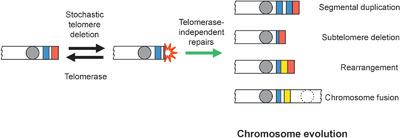Our official English website, www.x-mol.net, welcomes your
feedback! (Note: you will need to create a separate account there.)
Repair and Reconstruction of Telomeric and Subtelomeric Regions and Genesis of New Telomeres: Implications for Chromosome Evolution.
BioEssays ( IF 3.2 ) Pub Date : 2020-04-01 , DOI: 10.1002/bies.201900177 Chuna Kim 1, 2 , Sanghyun Sung 1 , Jun Kim 1 , Junho Lee 1
BioEssays ( IF 3.2 ) Pub Date : 2020-04-01 , DOI: 10.1002/bies.201900177 Chuna Kim 1, 2 , Sanghyun Sung 1 , Jun Kim 1 , Junho Lee 1
Affiliation

|
DNA damage repair within telomeres are suppressed to maintain the integrity of linear chromosomes, but the accidental activation of repairs can lead to genome instability. This review develops the concept that mechanisms to repair DNA damage in telomeres contribute to genetic variability and karyotype evolution, rather than catastrophe. Spontaneous breaks in telomeres can be repaired by telomerase, but in some cases DNA repair pathways are activated, and can cause chromosomal rearrangements or fusions. The resultant changes can also affect subtelomeric regions that are adjacent to telomeres. Subtelomeres are actively involved in such chromosomal changes, and are therefore the most variable regions in the genome. The case of Caenorhabditis elegans in the context of changes of subtelomeric structures revealed by long-read sequencing is also discussed. Theoretical and methodological issues covered in this review will help to explore the mechanism of chromosome evolution by reconstruction of chromosomal ends in nature.
中文翻译:

端粒和亚端粒区域的修复和重建以及新端粒的起源:对染色体进化的影响。
端粒内的 DNA 损伤修复受到抑制以维持线性染色体的完整性,但修复的意外激活会导致基因组不稳定。这篇综述提出了一个概念,即修复端粒 DNA 损伤的机制有助于遗传变异和核型进化,而不是灾难。端粒的自发断裂可以通过端粒酶修复,但在某些情况下,DNA 修复途径被激活,并可能导致染色体重排或融合。由此产生的变化也会影响与端粒相邻的亚端粒区域。亚端粒积极参与这种染色体变化,因此是基因组中最可变的区域。还讨论了长读长测序揭示的亚端粒结构变化背景下的秀丽隐杆线虫案例。本综述涉及的理论和方法学问题将有助于通过重建自然界中的染色体末端来探索染色体进化的机制。
更新日期:2020-04-01
中文翻译:

端粒和亚端粒区域的修复和重建以及新端粒的起源:对染色体进化的影响。
端粒内的 DNA 损伤修复受到抑制以维持线性染色体的完整性,但修复的意外激活会导致基因组不稳定。这篇综述提出了一个概念,即修复端粒 DNA 损伤的机制有助于遗传变异和核型进化,而不是灾难。端粒的自发断裂可以通过端粒酶修复,但在某些情况下,DNA 修复途径被激活,并可能导致染色体重排或融合。由此产生的变化也会影响与端粒相邻的亚端粒区域。亚端粒积极参与这种染色体变化,因此是基因组中最可变的区域。还讨论了长读长测序揭示的亚端粒结构变化背景下的秀丽隐杆线虫案例。本综述涉及的理论和方法学问题将有助于通过重建自然界中的染色体末端来探索染色体进化的机制。











































 京公网安备 11010802027423号
京公网安备 11010802027423号